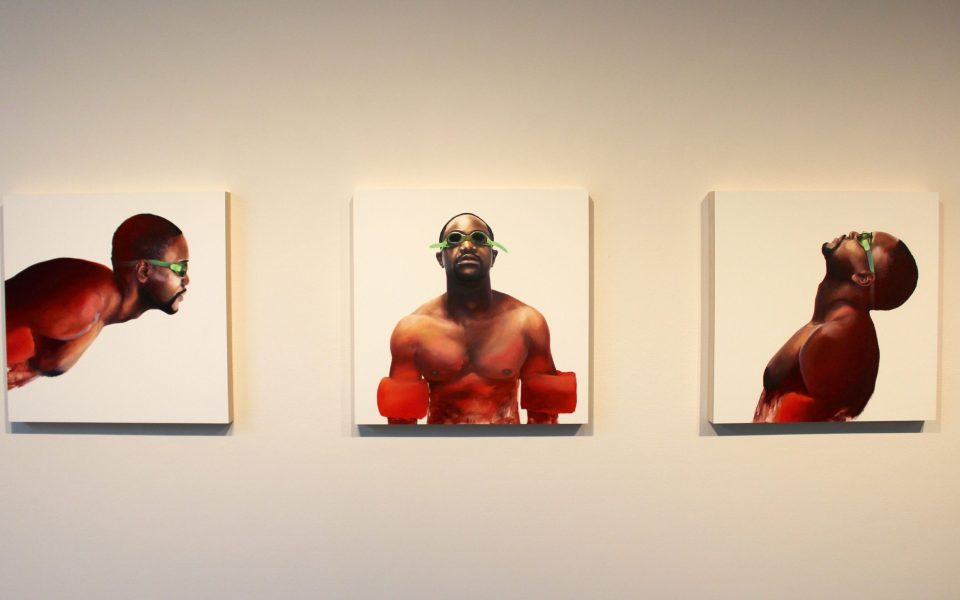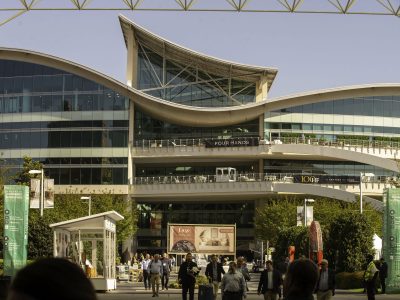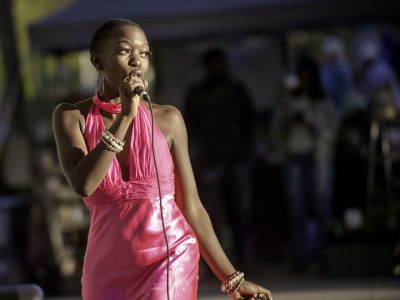Charles Williams deserves his own exhibit.
You don’t need any background to find Williams’ two series on display at the Weatherspoon Art Museum visually arresting. In the two first-floor rooms displaying the work of graduating MFA students of UNCG, Williams’ pieces stand out even among other compelling works. But once you know the backstory, it becomes obvious that Williams is a first-rate intellectual artist.
On Tuesday at noon, Williams and a half-dozen other graduating students presented impressive works, many of which tap into an explicit social consciousness. Each artist took a turn briefly introducing their art to a small cohort of friends, classmates and teachers. The exhibit includes an installation and video from Sherill Roland, who wore an orange prison jumpsuit to class and school functions for a year as part of his celebrated and wonderfully provocative Jumpsuit Project that illuminates the personal cost of incarceration.

©
Several apparel-themed pieces by Joyce Watkins King call attention to the costs of fast fashion, including an 80-pound, “Game of Thrones”–esque garment she assembled from thousands of gold keys. Caroline Bugby’s “Silver Dredger” spills forth from the back of one of the rooms, and is worth sitting in front of to fully take in. Indeed, each graduating student presents a unique, worthwhile concept that becomes all the more apparent when listening to them talk. Julia Caston, Kate Gordon and Codey Gallas — the other students in the exhibit — have much to be proud of, contributing alluring components to the display.
But Charles Williams should get his own exhibit.
His two series currently on display both tap into “Red Summer,” better known as the Chicago Race Riot of 1919. Williams teases out the history of the conflict’s origins, which began in a segregated swimming area. A black teenager drowned after being hit with a stone, touching off broader unrest.
In the self-portraiture series I AM, Williams poses shirtless, sporting green goggles and red floaties around his muscular biceps. He can’t swim, he admitted during his artist talk, but it’s on his bucket list. In the oil paintings, he leans in from the left for a side profile, faces the camera and leans his head back looking skyward for a right side profile in the third. There’s a purposeful parallel to mugshot poses, but the paintings look soft viewed up close.
Williams survived three near drownings himself, hence the three pieces. The paintings, which bleed gently into red — a callback to “Red Summer” — jump off the white background of the canvas. They’re masterfully executed, and despite being priced at $4,000 each, somebody already claimed the straight-on centerpiece.

©
Williams’ adjacent series, Untitled 1-10, depicts churning black waves on a series of square panels, lined up and fading towards whiteness. The thick oil paintings look almost like gasoline, and you could lose yourself in the tumult of the waves. Williams explained that the pieces were meant to mirror the idea of buoys demarcating the segregated Chicago beach, an incident he learned about while researching police violence and riots.
The waves are unsettling to stare into, which is intentional. Williams would anxiously wade waist-deep into the ocean in South Carolina — where he’s from — to take photos for the series, then quickly leave the water for the safety of the shore. Besides the obvious parallels to race and the role of water in the 1919 riot, water is also a unifying aspect of our shared humanity, Williams said, noting that we’re mostly made of water. The roiling waves spill from one square to the next as the darkness of the first few fades towards grey, and Williams said he’ll eventually add more to the series that run the spectrum towards whiteness.
It isn’t just one entranced culture writer and one loaded benefactor who recognize the skill of Williams’ work — he just found out that the North Carolina Museum of Art is buying some of his other work. They’ll pick it up Thursday, he said. And the Morris Museum of Art in Augusta, Ga. will feature I AM and the Untitled series in 2018, kicking off a tour.
If you don’t know about Sherill Roland’s work, you aren’t paying much attention. You could be forgiven for not knowing about Charles Williams, but you will assuredly regret missing the opportunity to see his thesis work before May 21. He is going places, and some day you’ll want to brag that you saw him back when.
UNCG’s 2017 MFA Thesis Exhibition is on display at the Weatherspoon Art Museum at 500 Tate St. (GSO) until May 21. Visit weatherspoon.uncg.edu for more info.

©
Join the First Amendment Society, a membership that goes directly to funding TCB‘s newsroom.
We believe that reporting can save the world.
The TCB First Amendment Society recognizes the vital role of a free, unfettered press with a bundling of local experiences designed to build community, and unique engagements with our newsroom that will help you understand, and shape, local journalism’s critical role in uplifting the people in our cities.
All revenue goes directly into the newsroom as reporters’ salaries and freelance commissions.





Leave a Reply